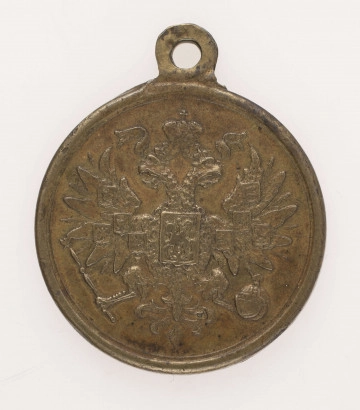
Medal for the suppression of the January Uprising
National Museum in Lublin
Part of the collection: Medals and historical orders
In European art, medallions first appeared in the first half of the 19th century. They usually depicted low-relief portraits of historical figures and personalities of national merit. The new art form emerged first in France, and its creators included well-known sculptors. Medallions were commissioned by individuals or institutions and cast in metal. They often served as family portraits that were hung on the walls of homes to commemorate loved ones. Presented medallion shows an image of Karol Levittoux (1820-1841), a Polish independence activist who committed suicide after being arrested and brutally investigated in a cell of the Warsaw citadel. Unwilling to hand over his comrades, he set fire to a hayloft and perished in the flames. News of his heroic death circulated throughout Europe, sparking widespread condemnation of the Tsarist regime. The death of Karol Levittoux inspired a romantic legend of sacrifice for the Homeland, eulogised in poetry and art. His heroic act is invoked by Cyprian Kamil Norwid in his poem Burza (The Storm) and a passage from his drama Za kulisami (Behind the Scenes), while Jerzy Andrzejewski, inspired by Norwid's drama, named his novel Popiół i diament (Ashes and Diamonds). Levittoux's character inspired many poets, such as Władysław Syrokomla, Mieczysław Romanowski, Roman Zmorski, Jan Kanty Radecki and Jerzy Czech. The bard of Solidarity, Przemysław Gintrowski, memorably sang about the hero, and the painter Antoni Kozakiewicz commemorated him with his painting The Death of Karol Levittoux (reproduction by Walery Rzewuski in the collection of the Museum of the Polish Army in Warsaw). The medallion is the work of Henryk Levittoux (1822-1879), Karol's brother, a popular Warsaw physician, philosopher and artist, who lived in Paris in the years 1844-1858. There he studied medicine and was engaged in art of making medals. The inscription engraved under the portrait is a tribute to his brother by the author of the medallion. Genowefa Horoszko
Author / creator
Object type
medallion
Technique
casting
Material
bronze
Origin / acquisition method
purchase
Creation time / dating
Creation / finding place
Owner
Muzeum Narodowe w Szczecinie
Identification number
Location / status

unknown
National Museum in Lublin

d`Angers, David
1851 — 1950
National Museum in Szczecin

Fabryka Mintera, Warszawa (1828-1881)
przed 1858
National Museum in Szczecin
DISCOVER this TOPIC
Castle Museum in Łańcut
DISCOVER this PATH
Educational path
0/500

We use cookies to make it easier for you to use our website and for statistical purposes. You can manage cookies by changing the settings of your web browser. More information in the Privacy Policy.
We use cookies to make it easier for you to use our website and for statistical purposes. You can manage cookies by changing the settings of your web browser. More information in the Privacy Policy.
Manage cookies:
This type of cookies is necessary for the website to function. You can change your browser settings to block them, but then the website will not work properly.
WYMAGANE
They are used to measure user engagement and generate statistics about the website to better understand how it is used. If you block this type of cookies, we will not be able to collect information about the use of the website and we will not be able to monitor its performance.